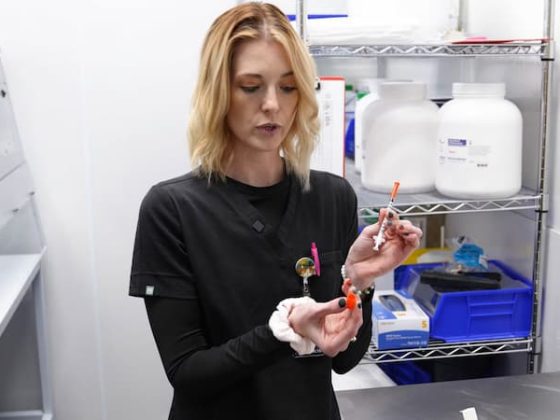Recently, medications like semaglutide and tirzepatide that target the GLP and GIP receptors in the brain have become hot items for weight loss treatment. While these drugs are effective, there are many wrong ideas circulating about them.
Let’s clear the air upfront—no, GLP-1 meds won’t turn you into a supermodel overnight, but they can help in more realistic ways. We’ll take a look at and debunk some of the most common misconceptions surrounding weight loss drugs.
Myth #1: Weight Loss Is Guaranteed with GLP-1 Medications
Semaglutide and tirzepatide have high success rates, but weight loss isn’t guaranteed. Your response to these medications could be different from a friend’s depending on factors like baseline weight and lifestyle changes made.
But don’t worry—it’s likely that you’ll see progress. A study found that 91% of people taking tirzepatide saw a weight reduction of 5% or more. And researchers learning about semaglutide found that participants lost an average of 15% of their body weight.
While results can be great—even life-changing—the fairy-tale ending can’t be guaranteed for everyone. If the medications don’t work the way you anticipated, talk with your doctor about dosing, your medication-taking routine, and your lifestyle.
Myth #2: You Don’t Need to Exercise While Taking GLP-1 Medications
The labels on your meds might not mention exercise, but going the extra mile by doing regular physical activity can help you sustain weight loss. After all, it’s those lifestyle adjustments that most reduce your risk of regaining weight.
Now, it’s true that these drugs can make significant changes just on their own, but research shows that the weight that you lose with them could include your hard-earned muscle mass. When you exercise along with taking GLP-1 medications, you’re more likely to maintain that lean muscle mass.
You don’t have to run a marathon, but let’s not skip the workout—think of it like pairing chips with salsa: way better together.
Myth #3: You Don’t Need to Eat Healthy Foods
Semaglutide and tirzepatide are pretty awesome, but they’re not magic meds. Nothing can replace healthy eating. Think about adding extra leafy greens or lean proteins to your diet, which are the dynamic duo of healthy eating. They’ll keep you energized and satisfied while also supporting you in your goals like a good friend.
And here’s a hard truth: a steady diet of sugary, greasy, or ultra-processed foods or drinks isn’t going to do you any favors—in fact, it could cause you some pain. GLP-1 medications slow the emptying of the stomach, so unhealthy foods may cause abdominal pain, nausea, or vomiting. Adopting a healthy diet will help you feel better on your weight loss journey.
Myth #4: All GLP-1 Weight Loss Medications Are the Same
Most GLP-1 weight loss medications are similar since they target some of the same receptors in the brain. But keep in mind that different brands like Mounjaro and Ozempic. While these name brands are well-known, compounded weight loss medications containing the same active ingredients may also be available. And they may cost you less out-of-pocket.
Different medications usually have different dosage amounts. For example, tirzepatide often comes in a stronger dose than semaglutide.
It’s not a ‘one-size-fits-all’ kind of deal. Think of these meds like shoes—they may look similar, but you’ve got to find the right fit for you. So always work with a healthcare provider to choose the medication that’s best for your needs.
Myth #5: There Are No Side Effects to Worry About
While GLP-1 medications are generally safe, there are side effects that all users need to be aware of. Some people report effects related to abdominal pain, like nausea, vomiting, and diarrhea.
We’d love to say it’s all sunshine and rainbows, but even the best things can come with a few bumps in the road. Pay attention to how your body responds to any medication. If something seems to be wrong, seek medical attention right away. No amount of weight loss is worth it if serious health issues come with it.
Plus, monitoring your body’s reaction helps make sure your treatment is both safe and effective for you. Every person’s body is different and can react differently to the same product.
Bonus: Do You Really Have to Take GLP-1 Medications Forever?
If you’re going through this process with the help of your doctor, you may find that your doctor will prescribe GLP-1 medications until you reach your target weight. The good news is that you might not have to commit to these meds until death do you part. Once you reach your goals, you could part ways.
At that point, you might be able to maintain your goal weight. That rides on whether you’ve stayed dedicated to living healthier habits. When you eat properly, exercise regularly, and incorporate other lifestyle changes, you may find that you don’t need to continue taking semaglutide or tirzepatide your whole life.
Each person reacts a little differently to GLP-1 medications, though, so you may find that you need to continue taking the medications along with implementing your lifestyle changes to maintain your goal weight.
The Final Word
Obviously, misconceptions around GLP-1 medications are common, but understanding the facts can lead to better expectations and results. You can have a better sense of how it will work and what the outcome might be.
At the end of the day, no medication can do all the heavy lifting for you—so get the facts, chat with your doctor, and take things one step at a time. A healthcare professional can tell you about the risks, benefits, and suitability of prescription weight loss medications for your specific body. They can also help you understand the cost of semaglutide without insurance.
And would you look at that? With just a little reading, you’re that much smarter about GLP-1 medications. It’s not hard to find some answers for yourself. With the right knowledge and support, you can take control of your health and your life.
Video

Infographic
Medications like semaglutide and tirzepatide are popular for weight loss. They target brain receptors and are effective, but many misunderstand them. Explore this infographic to debunk common myths about these drugs.









